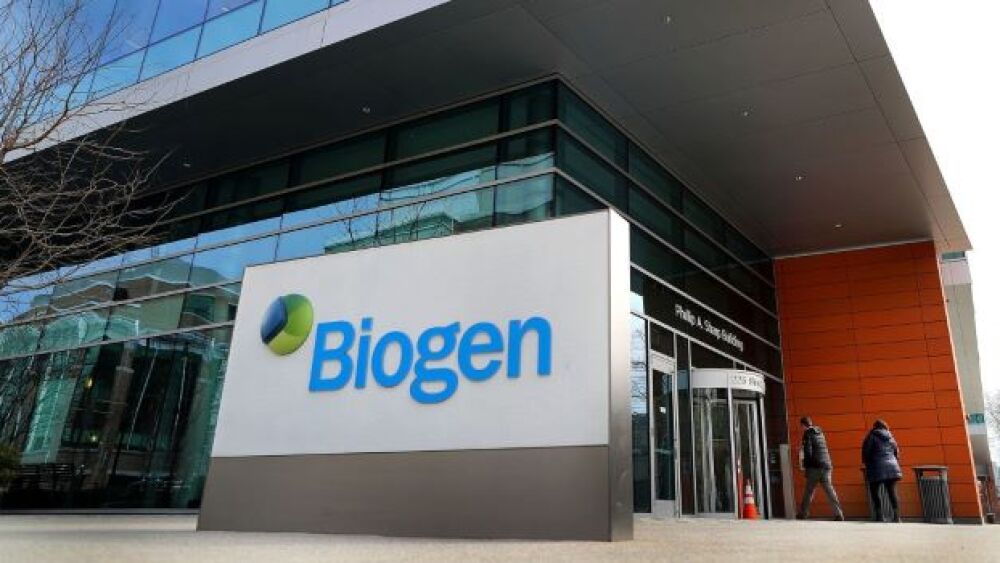One-year data indicates Biogen’s tofersen for SOD1-ALS, slows the decline of the disease through the lowering of SOD1 protein and neurofilament levels.
John Tlumacki/The Boston Globe via Getty
An in-depth review of pivotal one-year data indicates Biogen’s tofersen, being developed for a rare form of amyotrophic lateral sclerosis (ALS), slows the decline of the disease through the lowering of SOD1 protein and neurofilament levels.
The most significant reductions came when the medication was used in early intervention.
Biogen published the data analysis from the Phase III VALOR SOD1-ALS trial and open-label extension (OLE) study in the New England Journal of Medicine Wednesday.
The data shows earlier initiation of treatment with tofersen slowed patient decline across critical measures of function and strength in those diagnosed with superoxide dismutase 1 (SOD1) ALS, a genetic form of the disease.
The analysis, which adjusted for neurofilament levels as a marker of the disease progression rate, appears to support this conclusion.
Trial and OLE data showed SOD1 protein levels were reduced by 33% in patients who began treatment early, while those who started treatment at a later date saw only a 21% reduction.
Plasma neurofilament levels were reduced by 51% in the early-intervention group compared to 41% in the cohort that received the drug later.
SOD1-ALS is caused by mutations in the SOD1 gene. It affects approximately 2% of all ALS patients globally with life expectancy varying widely. Some patients survive less than a year following diagnosis. There is currently no targeted treatment for SOD1-ALS.
Developed by Biogen and Ionis Pharmaceuticals, tofersen is an antisense drug that binds and degrades SOD1 mRNA to reduce synthesis of SOD1 protein production.
When VALOR results were first announced in 2021, the study missed its primary endpoint. However, at the time, the companies pointed to positive trends in secondary endpoints.
The Neurofilament Factor
Dr. Merit Cudkowicz, a Harvard professor, co-principal investigator of the VALOR trial and chair of neurology at Massachusetts General Hospital, said the lowering of neurofilament along with the clinical data highlights tofersen’s potential for ALS patients.
Neurofilament is a marker of axonal injury and neurodegeneration.
“For some drugs, neurofilament could turn out to be a powerful surrogate marker,” Cudkowicz told BioSpace. “A drug that works right in motor neuron on the cause of illness like tofersen can reduce injury to motor neurons and therefore lower neurofilament levels.”
Other drugs, like ones that work on neuroinflammation, may slow progression and spread without impacting neurofilament, she noted.
Timothy Miller, M.D., principal investigator of VALOR and ALS Center co-director at Washington University School of Medicine in St. Louis, concurred.
“There is substantial lowering of neurofilament levels, which I interpret as potentially slowing the underlying disease process. This is clearly a good sign as it slows down the neurodegenerative process,” he told BioSpace.
Cudkowicz explained that with tofersen, the change in neurofilament came first, with the clinical effects being witnessed later. Some motor neurons may be unsavable with treatment while others can be, potentially resulting in stabilization following decline. She cautioned that this currently remains a hypothesis “but one that makes clinical sense.”
Cudkowicz added that it is also an argument for earlier intervention. The ATLIS study is assessing tofersen in pre-symptomatic people with SOD1 mutations. “This will also inform us a lot, but this will take time,” she said.
Cudkowicz noted that the majority of clinical trials are now measuring neurofilament, which means that within a year or so, there will be more data on hand to determine this pathway.
Even if the idea is supported by additional data, however, Cudkowicz said it would be unwise to throw out drugs that do not lower neurofilament.
Biogen and Ionis aim to win regulatory approval based on the use of neurofilament as a surrogate biomarker that is reasonably likely to predict clinical benefit.
In July, the FDA granted tofersen’s New Drug Application priority review. A PDUFA date has been set for Jan. 25, 2023.





